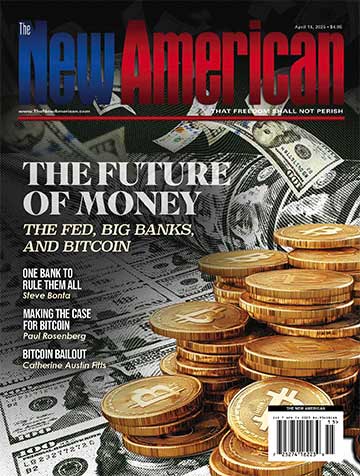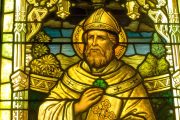
It was January, 1987. I gave a nine-hour lecture in Long Beach called Evidence of a Master Conspiracy. In attendance was a very handsome and nicely dressed gentleman who introduced himself to me as Tom Dorman, an M.D. cardiologist from San Luis Obispo. He endured the long day and my even longer-winded presentation and asked very thoughtful questions.
As we became friends, he confessed he had come to the meeting as a total skeptic, certain that he would be able to debunk my thesis. To his surprise, he was overwhelmed by the logic and evidence. He soon began to dig into that evidence and understanding, which we both owed to John Birch Society founder Robert Welch, and Tom mastered it superbly.
In a subsequent conversation, I said, “Tom, you now know how much the truth about history and world events has been suppressed or distorted. You must prepare yourself to relearn all that you know about medicine!”
“Well, I don’t know about that. What do you mean?” he replied, looking a bit defensive about his medical accomplishments.
I smiled, thinking of my dear friend, the late Congressman Larry McDonald, whose understanding of world events led him toward alternative medicine. “For you, Tom, my good friend, it’s just a matter of time!”
After that, fueled by an insatiable curiosity, a capacity for critical thinking, and a love of learning, Tom dived into a study of holistic medicine and alternative therapies. His practice refocused on alternative medicine, and he made a major contribution to that field and orthopedic medicine.
Tom learned about a diagnostic and treatment system for ligament-based joint pain. It is best known as prolotherapy or sclerotherapy, and its concepts date back to the mid-19th century. It was revived as far back as the 1930s by Dr. Milne Ongley and other physicians.
This applies to any joint in the body. For example, a person is standing and bends over to pick up something. When they stand back up, they feel pain radiating from the base of the spine up the back and down the legs. With conventional medicine, they may be condemned to take pain medication the rest of their life or endure surgery that usually has no benefit.
The prolotherapy physician must determine that the pain is ligament-based and not caused by something else like a ruptured vertebrae. The ligaments that connect our bones fatigue over time and when we move, they can fail to pull the bones back into proper alignment, putting pressure on nerves and causing pain. Once the diagnosis is clear, a non-toxic solution of sugar and other compounds are injected with a hypodermic needle into the ligament. This causes the ligament to swell and toughen, regaining the strength to pull the bones properly together. Many people are pain-free today because of this approach, and it has no side effects.
Within three years of my meeting him, Tom revived and tested this system, saw it help his patients, reported his findings in medical journals and authored (with radiologist Thomas H. Ravin) the major textbook: Diagnosis and Injection Techniques in Orthopedic Medicine (Baltimore: Williams & Wilkins, 1991). He has written many related articles for medical periodicals.
Today there are innumerable MDs, osteopaths, chiropractors and other physicians practicing prolotherapy and bringing relief to an untold number of patients around the world. Even though prolotherapy has a long history, Tom Dorman as a pioneer, mentor, and teacher deserves more credit for this progress than anyone else. When we got together, with a characteristically wry smile, he told his friends that I “ruined his life.”
Tom moved his practice to the Seattle area and administered prolotherapy, chelation, and other alternative approaches. This meant our visits became much less frequent. For years he published a fascinating and uniquely insightful newsletter, Fact, Fiction and Fraud in Modern Medicine. It contained a thorough explanation of his ever-expanding knowledge of holistic health and traced the historical struggle between individualism and collectivism, often applying one subject or context to the other. The content was always uniquely interesting and valuable but also made the reader sense his excitement and sheer joy in the learning process, in a manner than reminded me of Robert Welch’s The Romance of Education.
Thomas Dorman, M.D., of the Paracelsus Clinic in Federal Way, Washington, died unexpectedly on March 10, 2009, my birthday. He was 72. A most articulate individualist and patriot, Tom was born in British Kenya, where his father was a coffee merchant and during WWII helped supply travel documents for Jews escaping the Nazis. When communist Jomo Kenyatta came to power, the family moved to Israel, where Tom attended high school and later served in a parachute regiment during the 1967 war. Tom went to college in Liverpool and medical school in Edinburgh, and practiced in Canada before moving to America.
Tom believed that a physician should be responsible only to his patients, and so he refused to accept Medicare, Medicaid, Blue Cross, or any third-party payment, and worked against government takeover and destruction of conventional medicine. He also was a most articulate advocate of limited government and free-market economics. He is survived by his wife of 38 years, Alison; four children — Jill Coletti, Michael, Andrew, and Erin Hadley — and six grandchildren — Jill’s Benjamin and Joshua; Michael’s Mackenna and Micaela; and Erin’s Zoe and Sam.
Although Tom would probably have discovered his knowledge entirely on his own, it is rare when we get to point a friend in the right direction and he takes off and accomplishes miracles. I am blessed and proud to have known Tom Dorman and savor the way our lives influenced each other for over two decades. He knew that, whereas people sometimes let you down, valid principles never do. Godspeed, my most impressive, indispensable, and very beloved friend!
Photo of Dr. Thomas Dorman, M.D.




